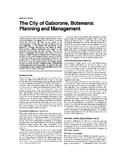| dc.contributor.author | Mosha, A.C. | |
| dc.date.accessioned | 2012-11-21T06:13:44Z | |
| dc.date.available | 2012-11-21T06:13:44Z | |
| dc.date.issued | 1996 | |
| dc.identifier.citation | Mosha, A.C. (1996) The city of Gaborone, Botswana: planning and management, Ambio, Vol. 25, no. 2, pp.118-125. | en_US |
| dc.identifier.issn | 0044-7447 | |
| dc.identifier.uri | http://hdl.handle.net/10311/1061 | |
| dc.description.abstract | In this paper we trace how Gaborone has grown from a very small village to the capital city of Botswana in a period of less than 30 years. Attention has been given to how careful design of master plan concepts has shaped the city and responded to the needs and aspirations of the residents. Through appropriate and enabling urban- development policies, standards and codes, a very amenable environment has been created. The city can boast of adequate and modern civic and commercial centers; modern functional infrastructure including water, electricity, roads and sewage systems; access to land for virtually all people; adequate housing provided by both the public and the private sectors and for the low income, the adoption of a very successful program of squatter upgrad- ing and self-help housing. Through careful management and development control practices, city growth has been contained quite well in spite of rapid development and the future of the city looks quite bright. | en_US |
| dc.language.iso | en | en_US |
| dc.publisher | Allen press, www.allenpress.com/ - | en_US |
| dc.title | The city of Gaborone, Botswana: planning and management | en_US |
| dc.type | Published Article | en_US |
| dc.link | www.jstor.org/stable/4314437 | en_US |

